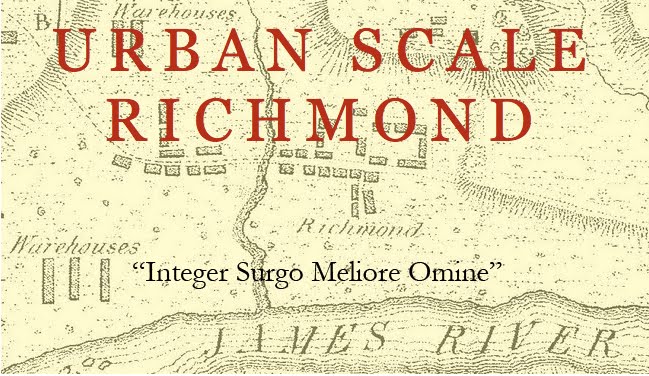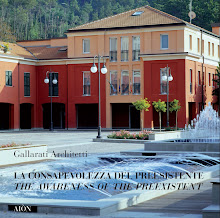 |
| Site of the Richmond Sports Complex on the 1865 Mickeler Map of Richmond. The Hermitage is part of "Camp Lee." |
Like most older cities, Richmond is rediscovering and redeveloping blocks of land that have been revalued by changing economic conditions. These tracts clearly defined by existing street locations, permanent physical barriers, and historic property boundaries.
One of these areas is the Sports Complex in North Richmond. Hemmed in by industrial areas on two sides and by transportation corridors on the north and south, the area has been targeted by the city's administration for redevelopment. Just like Shockoe Valley, the proposed site of a new ballpark (analyzed by us here), the Sports Complex has an interest history, if less fraught with injustice. The site is ideally located, not only for a regional sports venue, but for new commercial development , which the landlocked city needs to improve its tax base.
 |
| The Mayos' Hermitage by B. Henry Latrobe 1797 [Maryland Historical Society]. |
The site begins with a large triangular tract located north of the Westham or Three-Chopped Road, the main thoroughfare west of Richmond. This is the remainder of a large tract that was made up of six of the 100-acre lots sold in William Byrd's Lottery of 1767. Col. John Mayo, industrialist, moved there before 1789, setting up a country house or villa just far enough outside the city to permit him to take care of business, while providing a resort for his family during the warm months, away from the smells and sounds of the town center. An early road, known as Hermitage Road ran along the boundary between sets of 100-acre lottery lots and gave the tract its triangular shape.
 |
| The remaining section of the Hermitage tract from the 1942 Richmond Master Plan, showing the railroad and the parkway planned to parallel it. The Sports Complex is shown in orange. |
In 1804 a new turnpike was authorized to connect with the lands to the west and the coal mines in western Henrico and Goochland counties. The Richmond Turnpike (now Broad Street) cut across the Col. land and he laid out the southern portion in lots in 1816. Mayo's daughter Maria married the famous Gen. Winfield Scott in 1816 [Drew St. J. Carneal, Richmond's Fan District, 1996].
Much of the tract remained in family hands for many years- Scott's Addition, west of the boulevard and north of Broad, was developed in 1890 from the portion inherited by Maria and Winfield Scott from John Mayo in 1818. As the Fan District was extended to the west, Boulevard was laid out in 1875 as a grand cross street to connect Reservoir (Byrd) Park to Broad Street. It was eventually extended to intersect with Hermitage. This cut off the undeveloped section of the Hermitage which would become the Richmond Sports Complex as a triangular remainder that was never integrated into the grid.
In 1834, the Richmond, Fredericksburg and Potomac Railroad was extended across the Hermitage property. This began the use of the area north of Broad Street for a series of transportation corridors from the Seaboard Airline Railroad in 1900, which followed Bacon's Quarter Branch, to the Richmond Petersburg Turnpike in 1958. The availability of unused land and the accessibility of the railroad meant that the area was characterized by industrial development and by other uses that required larger tracts.
 |
| 1942 Master Plan of Richmond shows the industrial section following the railroad through the city. |
The triangular tract, which included the site of the original Hermitage dwelling, survived as undeveloped land well after the Civil War. The part extending from Board Street to the north became the site of the State Fair of Virginia in 1859. The fair moved north of the tracks to the tip of the triangle in 1906. The section south of the railroad became the site of Union (Broad Street) Station in 1917. Meanwhile the adjoining areas north of the railroad were laid out for light industrial and warehouse uses.
 |
| The arena in the 1970s. Its classical yet pragmatic detailing reveals its original use as the state fair's exhibition hall. |
The racetrack became famous for motorcycle and automobile races from the 1920s to the 1940s. Joe Pratali brought his Class “A” Speedway Racer (seen here) and Bill France, Sr. raced his open wheel roadsters known as "Big Cars."
 |
Richmond One-mile Dirt Racetrack, 1920s-40s (Joe Pratali Class “A” Speedway Racer seen here).
|
 |
| The Richmond Arena, aerial view, 1954, when it was a municipal garage. |
In the later 1950s, the Arena was known for roller skating when it wasn't in use for shows and sport events. In the 1970s, it became Richmond 's venue for professional wrestling booked by Crockett Promotions.
Parker Field was build as a stadium in 1934 as part of the state fair grounds. It was rebuilt as a minor league ball field in 1954 as the home of the Richmond Virginians and later the Richmond Braves. It was replaced by the present structure on the same site, known as the Diamond, in 1984. The Richmond Petersburg Turnpike and a new connector street, Robin Hood Road, were extended across the tip of the triangle, creating a green area later developed as "Travelland" and a public baseball field.
 |
| Parker Field, 1954 |
 |
| Parker Field |
 |
| The gates off Boulevard into the Arena and Parker Field looking north in the late 1950s. The "Toll Road" can be seen in the distance. |
 |
| Travelland and Westham Station |















No comments:
Post a Comment